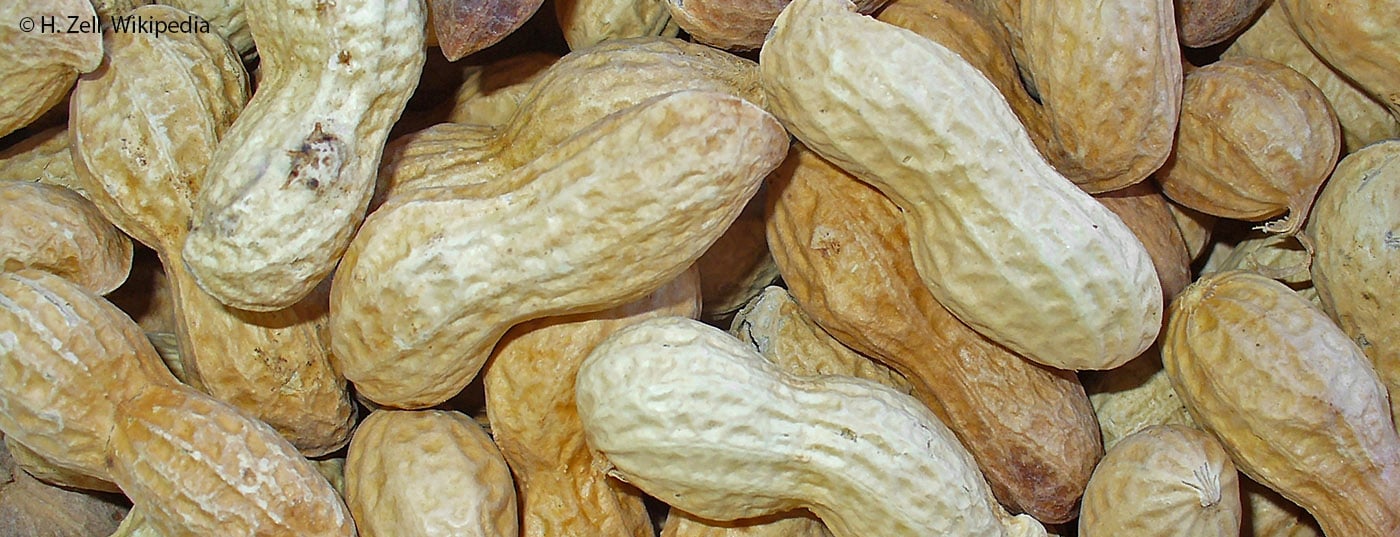Allergy to peanuts has been a highly topical issue in allergology for years: in the last decade, the prevalence in children in Western countries has doubled; moreover, peanut allergy is increasingly occurring in Africa and Asia. New preventive and therapeutic strategies were discussed at the 2015 AAAAI Congress in Houston: Does early use help reduce risk (LEAP study)? Will a skin patch soon usher in a new phase of specific treatment for peanut allergy (VIPES study)? As it seems at the moment, the answer to both questions is yes.
The LEAP (Learning Early About Peanut) study, published in the New England Journal of Medicine in parallel with the presentation at Congress [1], examined the effect of early peanut consumption in children at high risk for allergy.
640 children with severe eczema and/or egg allergy (risk factors for peanut allergy) were included [2]. One group consumed peanuts, the other did not. Median age at onset was 7.8 months. The intake was continued regularly until the age of 60 months. Peanut intake was predominantly with a child-friendly snack of peanut butter and corn called “Bamba” (at least 6 g of each peanut protein per week).
To be able to make more precise statements, the population was further specified: Children who were at least four months but younger than eleven months at baseline were divided into a cohort with a positive prick test to peanut extract (measurable wheal of 1-4 mm diameter, n=98) and into a cohort with a negative prick test result (n=530). Children with wheals larger than 4 mm were excluded from the study as a precaution.
An oral provocation at the beginning of the study was intended to show whether certain children in the consumption group already had severe allergic reactions. If this was the case, these children had to move to the waiver group. After 60 months, oral food tests were used to recheck how many children had developed a peanut allergy. Adherence for both consumption and abstinence was a very good 92%.
Fewer allergies thanks to consumption?
Allergy prevalence at the end of the study was 17.2% in the abstention group, but only 3.2% in the consumption group.
The 98 participants with positive test results at baseline had an allergy prevalence of 35.3% (abstention) and 10.6% (consumption) at the end of the study. This difference was significant (p=0.004) and corresponded to a relative prevalence reduction of 70% by peanut consumption.
The 530 participants with negative test results showed a prevalence of 13.7% (abstinence) and 1.9% (consumption), respectively. This difference also reached significance level (p<0.001) and corresponded to a prevalence reduction of an impressive 86.1%.
The larger the wheal in the prick test and the lower the ratio between peanut-specific IgG4 and IgE antibodies, the more likely was peanut allergy. Specific IgG4 antibodies increased mainly in the consumption group, which the authors suggest may reflect the protective role of the antibodies. The renounced group showed rather increased titers of specific IgE antibodies.
The incidence of serious adverse events or hospitalizations did not differ significantly between the two groups. No fatalities occurred.
Results should be incorporated into guidelines
The authors conclude that early consumption of peanuts significantly reduces the incidence of subsequent peanut allergy in children at high risk. This measure is effective not only in children who already show sensitization (secondary prevention), but also in children without this evidence (primary prevention). Furthermore, consumption alters the immune response.
However, the window of opportunity for such allergy prevention is narrow: children who develop eczema or egg allergy in the first months of their lives should therefore be subjected to a skin test and – if this is negative – consume peanuts at home at an early age. Children with positive test result (wheal 1-4 mm) must be monitored at the beginning when taking peanut products.
In principle, the authors recommend giving peanuts to children without eczema or allergies from the fourth month of life. However, this only applies to countries where peanut allergy is a social problem and, of course, peanuts must be reduced in size because of the risk of suffocation.
The study’s results also convinced experts such as former AAAAI President Hugh A. Sampson, MD, New York. He sees the study as a major advance in knowledge that, because of its clarity, will have an impact on food allergy guidelines and thus ultimately on clinical practice in the very near future. Such an effective strategy should be used as soon as possible, especially in view of the alarming increase in peanut allergy in recent years, he said. But even if enthusiasm prevailed at the congress – open questions remain: In what quantity and frequency should peanuts be consumed in concrete terms? And does the protection remain if you stop taking it?
Another problem is pre-existing allergies: At some American schools and kindergartens, all children are forbidden to bring peanuts or peanut butter, without exception, because some students already have severe allergies. Recommending the blanket supply of peanuts to children also increases the risk of exposure for allergy sufferers.
Conclusion: Although prevention is one of the most important therapeutic approaches, it is not sufficient on its own – effective tools are also needed to combat an existing allergy. This was the subject of another study that attracted attention at the AAAAI Congress.
Skin patch under development as new therapy method
The Phase IIb results for the patch, named Viaskin® Peanut, were eagerly awaited. The innovative desensitization approach for people who already suffer from peanut allergy is also called EPIT, “epicutaneous immunotherapy.” A patch applied to the skin releases very small doses of peanut proteins, inducing tolerance. The associated double-blind, placebo-controlled study called VIPES (Viaskin Peanut’s Efficacy and Safety) is the largest ever conducted on peanut desensitization [3].
In 221 peanut allergic patients, 51% of whom were children, 33% adolescents, and 16% adults, the patch was tested in protein doses of 50, 100, or 250 µg, for a total of one year. At baseline and at the end of the study, we determined the reactivity or objective tolerance level of the participants via an oral, randomized and controlled peanut exposure (“food challenge” or food test). Participants applied the Viaskin® patch and analogously the placebo patch daily for 24 hours either on the back (children under 12 years) or on the inner upper arm.
In particular, the 250 µg dose (n=56) was promising: after one year, significantly more verum than placebo patients reached the primary endpoint (50 vs. 25%; p= 0.0108). This was defined as tolerance to at least 1000 mg of orally ingested peanut protein (equivalent to approximately four peanuts) or an increase in tolerated intake of at least 10-fold (since baseline). The patches with the lower doses did not work better than the placebo patches.
The subgroup of children showed a particularly robust response to immunotherapy (at 250 µg 53.6 vs. 19.4%; p=0.008). Considering that about half of all children initially reacted already to ≤50 mg peanut proteins, the result is even more impressive. Peanut-specific IgG4 levels were significantly elevated, 19-fold in the high-dose group of children under 12 years of age. Specific IgE levels also increased initially, as is the case with many immunotherapies, but then declined to baseline levels during the year. The adolescent subgroup showed a trend toward better tolerance (38.9 vs. 22.2%, n.s.). In adults, the results were not conclusive.
Compliance was over 95%. No serious adverse events related to the patch occurred. Less than 1% of participants dropped out of the study due to patch-specific adverse events (atopic dermatitis at the patch site). Overall, the drop-out rate was low for an immunotherapy trial at 6%. This “excellent” safety/tolerance profile, according to lead study author Hugh Sampson, makes EPIT a promising candidate for early approval, even though EPIT is less effective than its oral counterpart (oral immunotherapies are also currently being tested in trials, but with higher rates of side effects).
Approval would be tantamount to a medical breakthrough, as there is currently no specific therapy for peanut allergy. Of course, don’t expect a “cure” for the allergy, Sampson said; rather, the goal is to prevent dire consequences from the unintentional ingestion of foods containing traces of peanuts. Moreover, according to the current state of knowledge, immunotherapy requires continuation in principle indefinitely: if one suspends exposure, reactivity will return sooner or later. Another subject of discussion is the required level of the tolerance threshold: Is 1000 mg already enough or should one aim for higher values?
The VIPES study has since been extended for another year. It will be interesting to see whether the benefit continues to increase. In addition, a phase III trial is planned.
Source: Annual Meeting American Academy of Allergy, Asthma & Immunology, February 20-24, 2015, Houston.
Literature:
- Du Toit G, et al: Randomized Trial of Peanut Consumption in Infants at Risk for Peanut Allergy. N Engl J Med 2015; 372: 803-813.
- Du Toit G, et al: Identifying infants at high risk of peanut allergy: the Learning Early About Peanut Allergy (LEAP) screening study. J Allergy Clin Immunol 2013 Jan; 131(1): 135-143. e1-12.
- DBV Technologies (Sponsor): A Double-blind, Placebo-controlled, Randomized Trial to Study the Viaskin Peanut’s Efficacy and Safety for Treating Peanut Allergy in Children and Adults. NCT01675882 (available at ClinicalTrials.gov).
DERMATOLOGY PRACTICE 2015; 25(2): 37-39











